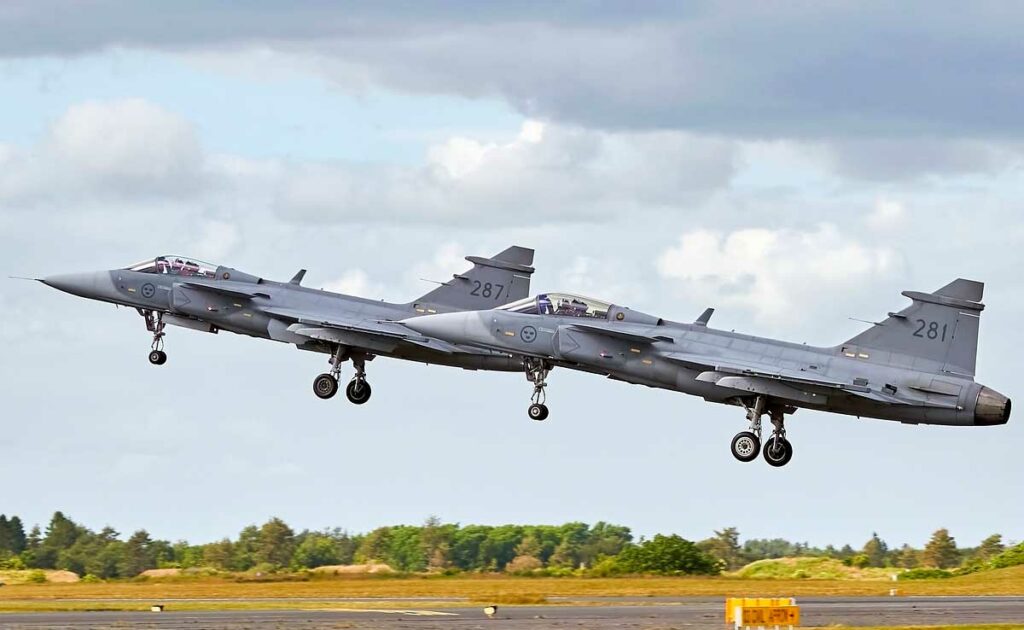
Saab’s Gripen E incorporates Centaur AI to conduct combat beyond visual range, a breakthrough tested against a piloted aircraft.
Between May 28 and June 3, 2025, Saab conducted flight tests of a version of the Gripen E equipped with the Centaur artificial intelligence agent developed by Helsing. This AI was integrated without major modifications, thanks to the aircraft’s open architecture. It enabled autonomous beyond visual range (BVR) engagements against a piloted Gripen D. Centaur performed complex maneuvers, provided firing instructions, and demonstrated a simulated rapid learning rate equivalent to several decades of human flight. This test is part of Sweden’s Project Beyond program, which is preparing future combat aircraft, particularly in the context of potential threats in Northern Europe.
The technological context of the Centaur program
The Centaur program was developed in Sweden within a clear government framework. It is funded by the Defense Materiel Administration (FMV), the Swedish equivalent of the French DGA, as part of Project Beyond. This program aims to test the use of embedded artificial intelligence in air combat scenarios, primarily Beyond Visual Range (BVR) engagements, which account for more than 70% of fire exchanges recorded in modern conflicts.
The integration was made possible by the Gripen E’s open electronic architecture, which allows software modules to be quickly inserted without major redesign of the weapon system. This software approach avoids years of certification, unlike American aircraft such as the F-16 modified to X-62A VISTA, which requires a rigid test environment limited to experimental military bases.
The tests were conducted in Sweden and involved an autonomous Gripen E flying against a piloted Gripen D, with support from an AEW\&C surveillance aircraft. Three missions were completed at various distances, speeds, and angles. The Centaur system executed combat maneuvers, identified optimal firing moments, and autonomously assisted the pilot in managing the cognitive load.
This technology is part of Sweden’s doctrine of asymmetric technological superiority, which is essential for a small air force that needs to compensate for numerical inferiority, particularly in the event of a regional conflict with Russia.

The technical performance of the Centaur agent
The Centaur artificial intelligence system operates on the principle of simulated reinforced learning. In the pre-test phase, it absorbed several thousand hours of simulated flight time based on data from the Gripen E simulator. According to Helsing, a single test sequence enabled the AI to acquire the equivalent of 50 years of human flight time in just a few hours, thanks to massively parallelized virtual battles.
In real combat, Centaur used the Gripen E’s sensors (AESA radar, data fusion, tactical links) to acquire targets, predict their trajectories, and determine optimal firing windows. It then transmitted firing instructions to the pilot while executing positioning maneuvers. The AI was tested in configurations with and without command links to validate its autonomy in degraded situations.
This type of BVR combat is extremely complex, compared by Saab to a chess game played at Mach 1.5, with missiles such as the Meteor capable of intercepting a target at a distance of over 150 km. Decisions must be made in a matter of seconds, based on dozens of dynamic parameters.
The AI’s ability to react to sudden changes (opponent’s trajectory break, jamming, radio silence) is therefore a major operational advantage. It frees the pilot from the most time-consuming and repetitive tasks, allowing human attention to be focused on broader strategic decisions.
Operational implications for air forces
The adoption of autonomous AI such as Centaur could profoundly change the way armies manage air engagements. For countries with limited fleets, such as Sweden and Finland, the added value of a reliable digital co-pilot capable of processing information at high frequency would multiply the operational efficiency of the same number of aircraft.
Furthermore, the implementation of Centaur in the Gripen E paves the way for its use in future platforms, including unmanned ones, such as the Flygsystem 2025 demonstrator or future autonomous combat drones. The Swedish model focuses on adaptability: the same software system could be used in several types of aircraft, reducing integration and training costs.
On a tactical level, AI would enable a small group of fighters equipped with BVR missiles such as the Meteor or IRIS-T to simultaneously intercept multiple targets at long range without cognitive overload for the pilot. This model, based on partially autonomous swarms, is reminiscent of concepts developed in US programs such as VENOM and CCA (Collaborative Combat Aircraft), but with a more direct level of operational maturity.

Medium-term strategic and industrial consequences
The results of the Centaur program go beyond technological aspects: they are reshaping the industrial and strategic balance in the field of sixth-generation air combat. Saab highlights the rapid integration capability of the software, which was achieved in less than six months from the start of the collaboration with Helsing. This responsiveness contrasts with the sluggishness of NGAD (Next Generation Air Dominance) projects in the United States, whose costs exceed €10 billion per prototype.
The Gripen E could become a strategic export vehicle, particularly for Saab customers such as Brazil, which is developing a two-seater version (Gripen F) for its own doctrine. The exportability of an AI module that is so lightweight in terms of integration and not subject to ITAR (International Traffic in Arms Regulations) regulations may also appeal to other regional partners.
Sweden, meanwhile, is preparing its future air combat system for 2031. The data collected via Centaur, even if the system is not directly integrated into front-line units, will be used to train future algorithms and refine doctrines. Saab could thus offer a competitive intermediate solution to Franco-German platforms such as FCAS, which are still at the conceptual stage.
War Wings Daily is an independant magazine.